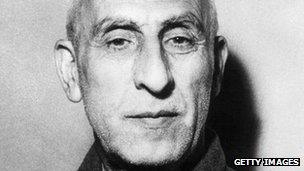CIA documents acknowledge its role in Iran's 1953 coup
- Published
BBC Persian's Khashayar Joneidi looks at events surrounding the 1953 coup
The CIA has released documents which for the first time formally acknowledge its key role in the 1953 coup which ousted Iran's democratically elected Prime Minister, Mohammad Mossadeq.
The documents were published on the independent National Security Archive, external on the 60th anniversary of the coup.
They come from the CIA's internal history of Iran from the mid-1970s.
"The military coup... was carried out under CIA direction as an act of US foreign policy," says one excerpt.

Prime Minister Mossadeq was overthrown after a bid to renationalise Iran's oil industry
The US role in the coup was openly referred to by then US Secretary of State Madeleine Albright in 2000, and by President Barack Obama in a 2009 speech in Cairo.
But until now the intelligence agencies have issued "blanket denials" of their role, says the editor of the trove of documents, Malcolm Byrne.
This is believed to be the first time the CIA has itself admitted the part it played in concert with the British intelligence agency, MI6.
Mr Byrne says the documents are important not only for providing "new specifics as well as insights into the intelligence agency's actions before and after the operation", but because "political partisans on all sides, including the Iranian government, regularly invoke the coup".
The documents were obtained under the Freedom of Information Act by the National Security Archive, a non-governmental research institution based at George Washington University.
Iranians elected Mossadeq in 1951 and he quickly moved to renationalise the country's oil production, which had been under British control through the Anglo-Persian Oil Company - which later became British Petroleum or BP.
That was a source of serious concern to the US and the UK, which saw Iranian oil as key to its post-war economic rebuilding.
The Cold War was also a factor in the calculations.
"[I]t was estimated that Iran was in real danger of falling behind the Iron Curtain; if that happened it would mean a victory for the Soviets in the Cold War and a major setback for the West in the Middle East," says coup planner Donald Wilber in one document written within months of the overthrow.
"No remedial action other than the covert action plan set forth below could be found to improve the existing state of affairs."
The documents show how the CIA prepared for the coup by placing anti-Mossadeq stories in both the Iranian and US media.
The coup strengthened the rule of Shah Mohammad Reza Pahlavi - who had just fled Iran following a power struggle with Mossadeq and returned following the coup, becoming a close ally of the US.
The US and UK intelligence agencies bolstered pro-Shah forces and helped organise anti-Mossadeq protests.
"The Army very soon joined the pro-Shah movement and by noon that day it was clear that Tehran, as well as certain provincial areas, were controlled by pro-Shah street groups and Army units," Wilber wrote.
"By the end of 19 August... members of the Mossadeq government were either in hiding or were incarcerated."
The Shah returned to Iran after the coup and only left power in 1979, when he was overthrown in the Islamic revolution.
- Published6 January 2020